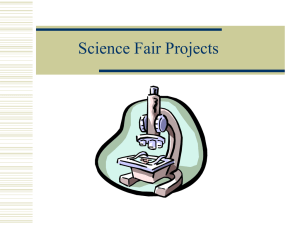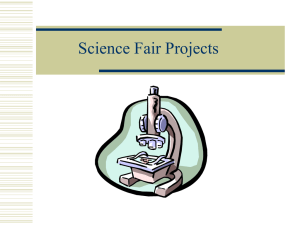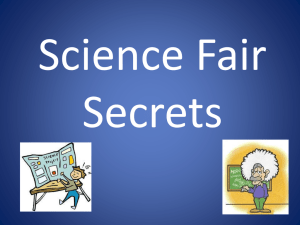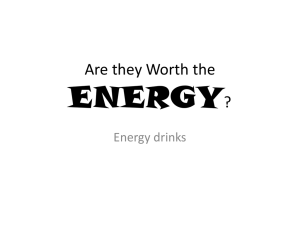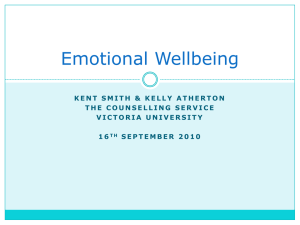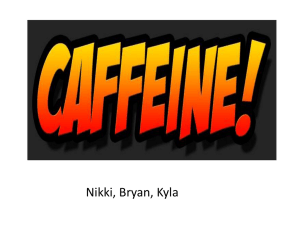Caffeine - 60 min
advertisement
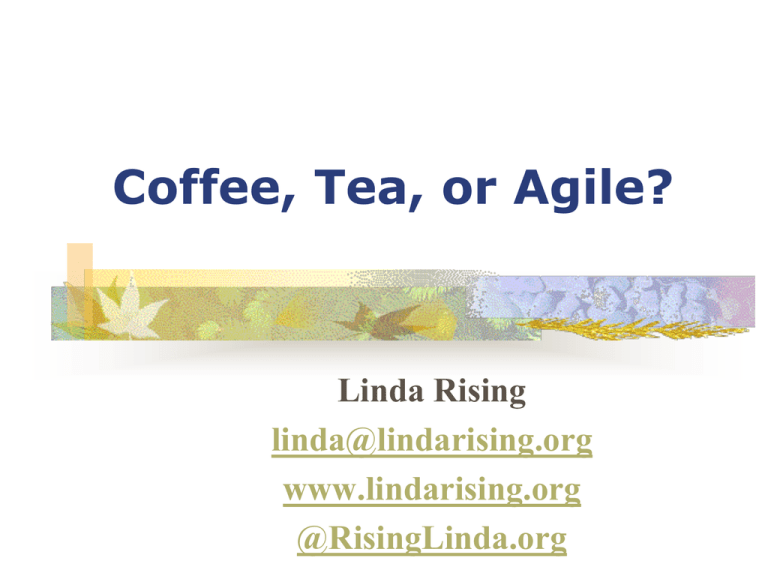
Coffee, Tea, or Agile? Linda Rising linda@lindarising.org www.lindarising.org @RisingLinda.org Caffeine – our drug of choice The world’s most popular drug, easily surpassing nicotine and alcohol. The only addictive, psychoactive substance to be freely available almost everywhere, unregulated, sold over the counter, without license. Added to beverages designed for children. Coffee, tea, or chocolate? Arrived in the West ~1600 Different taste and smell, but all contain significant amounts of caffeine. Caffeine-yielding plants discovered in Paleolithic times, as early as 700,000 B.C.E. Stone Age humans chewed seeds, roots, bark, leaves of plants or ground plant material to a paste before ingestion. Clocks! During medieval times, schedules were lax, holidays many, disorganization pervasive. No accurate timepieces. The uniformity of pendulum motion was discovered by Galileo in 1583, and came into general use over the next 100 year. Serendipity! For most of human existence, sleep and wakefulness was determined by the sun and the seasons. The clock and caffeine were essential to the surge in economic growth started in England ~1800—The Industrial Age! Workers had to adapt and cope with a schedule set by a clock, not by daylight or the natural sleep cycle. Beer for Breakfast Heat beer in a saucepan. In a separate small pot beat a couple of eggs. Add chunk of butter to the hot beer. Stir in some cool beer, then pour over the eggs. Add salt, and mix, whisking to keep from curdling. Europeans averaged ~3 l beer/person/day. India and China had great civilizations while Europeans were staggering around in a drunken stupor ! Words from an ancient sage In wine there is wisdom. In beer there is freedom. In water there is bacteria. Caffeine vs. Alcohol Caffeine is soluble in hot water. Boiling water helped decrease the incidence of disease in crowded cities. Caffeine facilitated the great transformation of human economic endeavor from the farm to the factory in the West. How does it work? Moves easily from stomach and intestines to the bloodstream, to the organs, and almost every cell of the body. Crosses the blood-brain barrier, reaches its peak concentration in the brain in ~1 hour. Caffeine blocks the effect of adenosine (one of the body’s natural sleeping pills) and keeps us from falling asleep. New journal Caffeine Research Rates of metabolism Half-life of caffeine in adults ~3.5 hrs Women on the pill ~5.5 hrs Pregnant women ~10 hrs Caffeine in babies Fetus/newborn unable to metabolize caffeine Most babies in the developed world are born with traces of caffeine in their bodies Half-life in infants ~100 hrs Infant’s half-life slowly decreases, reaches adult level by 8 months, but not mature until 1 yr. Caffeine + Nicotine Nicotine moderates mood, extends attention, doubles the rate of caffeine metabolism. The original coffeehouse was a place where men could sit and smoke and drink. The tobacco they smoked made it possible to drink coffee all day. The coffee they drank inspired them to talk all day. Out of this came the Enlightenment ! The downside We try to take control away from our hardwired circadian rhythm. But we pay a heavy price for the extra wakefulness. Without adequate sleep, ~7 hours/day, the human body will not function at its best, physically, mentally, or emotionally. The global average, hours of sleep/night is decreasing. Productivity Myths Sleeping and breaks are a waste of time. The best way to solve problems is to put in as much time as possible without stopping. No one takes naps except babies and old people. If you are not doing serious WORK, you are slacking off and not contributing. Honore de Balzac, great and prolific French writer was a caffeine addict. For awhile, you can obtain the right amount of stimulation with one, then two cups of coffee brewed from beans crushed with gradually increasing force and infused with hot water. By decreasing the amount of water, by pulverizing the coffee even more finely, by infusing the grounds with cold water, you can obtain the same cerebral power. Ideas quick-march into motion like battalions of a grand army to its legendary fighting ground, and the battle rages. Memories charge in, bright flags on high; the cavalry of metaphor deploys with a magnificent gallop, the artillery of logic rushes up with clattering wagons and cartridges; on imagination's orders, sharpshooters sight and fire; forms and shapes and characters rear up; the paper is spread with ink, the nightly labor begins and ends with torrents of this black water. In the end, Balzac resorted to eating dry coffee grounds to achieve the desired effect. He died at age 49. The Swedish Experiment King Gustav III (ruled Sweden latter half 18th century) hated/feared coffee and devised an experiment. One convicted murderer was sentenced to drink coffee daily until he died. A second murderer was sentenced to a lifetime of tea drinking as a control. Gustav was murdered and doctors in charge of the study died before the tea drinker (of old age at 83), leaving the original murderer alone with his espresso. Caffeine no better than breaks Caffeine improves “vigilance tasks” - prolonged attention, little physical activity. Effects most apparent after long effort, minimal when tasks just begun. When allowed to take breaks no significant benefit from caffeine. Good night’s sleep improves performance, mood, alertness better than caffeine. Benefits last longer than caffeine (loses effect within 6 hrs). NASA Studies 26 min nap improves performance by 34% and alertness by 54% Caffeine nap: takes 20 min for caffeine to have full effect, so drink caffeine and take 20 min nap Nap Tips Best nap time: 1-3 p.m. hardwired low energy period 20 min: improves motor skills 30 min: improves memory 90 min: makes connections between new info & existing memories Practice makes perfect. Non-nappers slower to wake and more groggy. Don't nap within 3 hrs of bedtime Faster but not better? Caffeine improves the performance of simple, familiar, routine tasks, and impairs or fails to affect the accomplishment of complex, novel, unfamiliar tasks—perhaps by causing people to work more quickly but possibly less carefully. Caffeine stimulates fast, strong, but incorrect reactions. Introverts vs. Extroverts When posed with challenging mental tasks, e.g. solving mathematical problems, impulsive, extroverted people get a boost in performance from caffeine, while the less impulsive and more introverted tended to suffer marked detriments. All seem to do better the higher the dose, for simple tasks. On complex tasks, extroverts’ performance improved depending on the dose, while the introverts got worse. Trouble with Experiments Creating a control group is difficult because nearly everyone is “on” caffeine. Withholding caffeine puts the control group at a disadvantage. Stopping caffeine use has been shown to impair performance. Perhaps the results that show improved performance are really showing the effects of caffeine withdrawal? Spiders on Drugs And our children? All the sugar + twice the caffeine 1985 – 72 mg caffeine in 12 oz 1987 - 80 mg caffeine in 8 oz 1 tsp = 400 mg caffeine Caffeinated Snacks Perky Jerky 150 mg per bag Maple Bacon-Flavored Lollipop 80 mg caffeine per pop 200 mg in 5 minutes Caffeine + Alcohol Is Agile the new “caffeine”? Energizing Stimulating Fun Addictive No side effects? Irritability Restless Anxious Sleepless But… Agile teams can get themselves into hot water ! Good for teams? Good for us? Is it possible to apply an approach that works well for teams to our own lives? Are we assuming that what was good in the Industrial Age should still be good for us now? Should we be experimenting, learning, working toward the goal of living our lives in the best possible way? No answers, just questions. Thanks for listening! Save 40%* at informit.com Discount code: AGILESINGAPORE bit.ly/fearlesschang e List price: $38.39 Your Price: $23.03 *Offer good on eBook only and expires November 29, 2014 Includes EPUB, MOBI, and PDF

